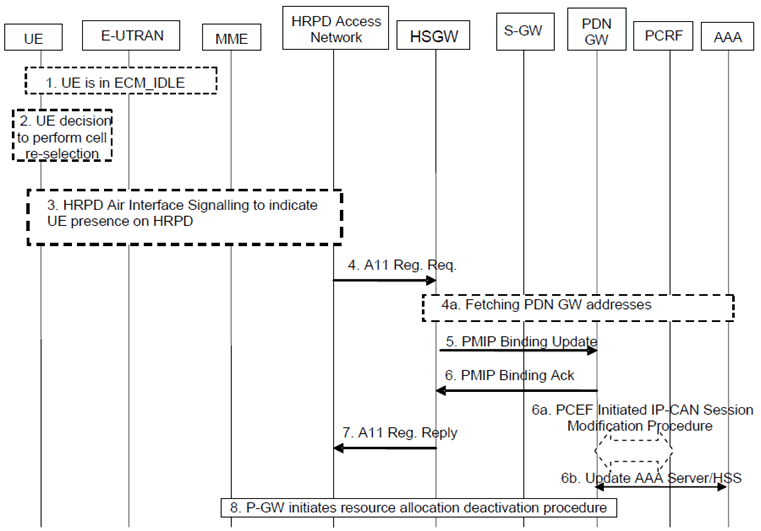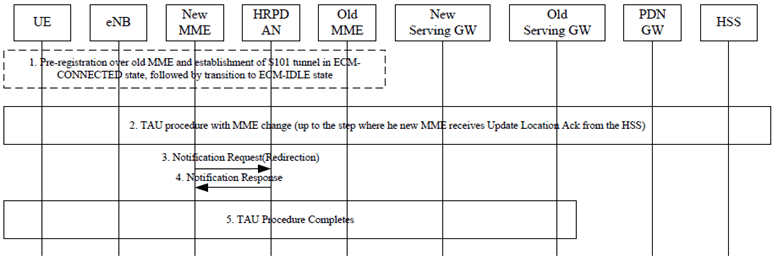Content for TS 23.402 Word version: 18.3.0
0…
4…
4.2…
4.2.2
4.2.3
4.3…
4.4…
4.5…
4.5.7…
4.6…
4.7…
4.7.2…
4.8…
4.8.2a…
4.9…
5…
5.2…
5.4…
5.5
5.6…
5.7…
5.8…
6…
6.2…
6.3
6.4…
6.4.3…
6.5…
6.6…
6.7…
6.8…
6.10…
6.13…
6.15…
7…
7.2…
7.3
7.4…
7.5…
7.6…
7.8…
7.10…
8…
8.2.1.2
8.2.1.3…
8.2.2
8.2.3…
8.2.6…
8.3…
8.4…
8.5…
9…
9.3…
9.4…
10…
13…
16…
16.1.2…
16.1.6…
16.2…
16.2.1a…
16.3…
16.4…
16.7…
16.8…
16.10…
17…
A…
C…
E…
9.4 Optimized Idle-mode Mobility: E-UTRAN Access to cdma2000 HRPD Access
9.7 S101 Tunnel Redirection Procedure
...
...
9.4 Optimized Idle-mode Mobility: E-UTRAN Access to cdma2000 HRPD Access p. 234
This procedure is used in the case the UE has a dormant HRPD session in the target HRPD network, either through the pre-registration procedure or previous HRPD attachment.

Step 1.
The UE is attached to E-UTRAN network and stay in ECM_IDLE state. The UE has a dormant HRPD session in the target HRPD network, either through the pre-registration procedure or previous HRPD attachment
Step 2.
The UE is in idle mode. Based on some trigger, the idle UE decides to perform cell re-selection to the HRPD system. Note, the cell re-selection decision can be made at any time when the UE is attached in the E-UTRAN network (including as soon as the UE has completed pre-registration).
Step 3.
The UE follows 3GPP2 procedures in 3GPP2 C.S0087-0 [49] to inform the HRPD access network the UE has performed an inter-technology idle mode mobility event and is now tuned to HRPD.
Step 4.
The HRPD access indicates to the HSGW that the UE has moved to HRPD.
Step 4a.
The HS-GW fetches the PDN-GW identity for all the active PDN connections from the 3GPP AAA Server.
Step 5~6.
The HS-GW exchanges a PMIP BU/BA with the PDN-GW. The UE address information in PMIP BA returns the IP Address assigned to the UE. In this message, the Charging ID is also carried for charging correlation purposes. At this point the user plane is switched in the PDN-GW towards the HRPD access network via the HS-GW. Multiple PDN connections to the same APN can be supported using PDN connection identities in the same way as it is specified for S2a procedures.
Step 6a.
The PDN-GW executes a PCEF-Initiated IP-CAN Session Modification Procedure with the PCRF as specified in TS 23.203 to obtain any new QoS policy and charging rules for all the active sessions as a result of the handover procedure. Since steps 6 and 6a are both triggered by the Proxy Binding Update in step 5, steps 6 and 6a may occur in parallel.
Step 6b.
The PDN-GW informs the 3GPP AAA Server of its PDN-GW identity and the APN corresponding to the UE's PDN Connection and obtains authorization information from the 3GPP AAA Server. The message includes information that identifies the PLMN in which the PDN-GW is located. The 3GPP AAA Server may update the information registered in the HSS as described in clause 12.
For multiple PDN connections, steps 5-6 and 6a-6b are performed for each PDN connection.
Step 7.
The HS-GW acknowledges the HRPD access network.
Step 8.
At any time after step 6, the P-GW shall initiate the PDN-GW Initiated PDN Disconnection procedure as defined in clause 5.6.2.2, so that any resources are released in the EPS serving nodes that were serving the UE in E-UTRAN access before the idle-mode mobility to HRPD took place.
9.5 Void
9.6 Void
9.7 S101 Tunnel Redirection Procedure p. 235
S101 Tunnel Redirection Procedure is used when the UE performs TAU with MME change while the UE has already triggered a pre-registration procedure from LTE to the HRPD as described in clause 9.3.1 and the S101 session exists between the MME and the HRPD Access Network.
The detail procedure for the idle case is depicted as Figure 9.7-1.

Step 1.
The detailed procedure for the active case is depicted as Figure 9.7-2.
UE performs pre-registration over the old MME while in ECM-CONNECTED state, followed by transition to ECM-IDLE state. The S101 tunnel exists between the old MME and the HRPD Access Network.
Step 2.
TAU procedure with MME change is executed as described in TS 23.401, Figure 5.3.3.1-1, up to the step where the new MME receives Update Location Ack from the HSS. The HRPD Access Network IP address is transferred to the new MME via the Context Response message.
Step 3.
The new MME sends Notification Request (Redirection, S101 Session ID) message to the HRPD Access Network. After receiving this message, the HRPD Access Network associates the S101 tunnel for this specific UE with the new MME. Then the HRPD Access Network releases any context associated with the old MME.
Step 4.
In response to the Notification Request message, the HRPD Access Network sends a Notification Response (S101 Session ID) message to the target MME.
Step 5.
The TAU procedure is completed.

Figure 9.7-2: S101 tunnel redirection during inter-eNodeB handover with MME relocation
(⇒ copy of original 3GPP image)
(⇒ copy of original 3GPP image)
Step 1.
UE performs pre-registration over the old MME while in ECM-CONNECTED state. The S101 tunnel exists between the old MME and the HRPD Access Network.
Step 2.
Inter-eNodeB handover with MME relocation procedure is executed as described in TS 23.401, Figure 5.5.1.2.2-1, steps up to TAU. The HRPD Access Network IP address is transferred to the new MME via the Forward Relocation Request message.
Step 3.
The new MME sends Notification Request (Redirection, S101 Session ID) message to the HRPD Access Network. After receiving this message, the HRPD Access Network associates the S101 tunnel with the new MME. Then the HRPD Access Network releases any context associated with the old MME.
Step 4.
In response to the Notification Request message, the HRPD Access Network sends a Notification Response (S101 Session ID) message to the target MME.
Step 5.
The TAU procedure occurs.